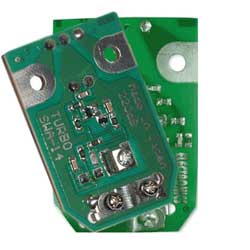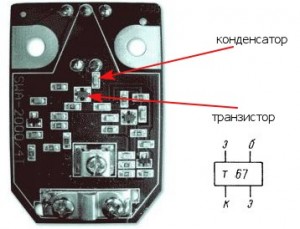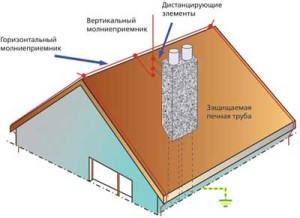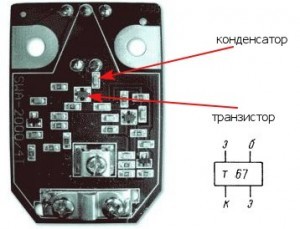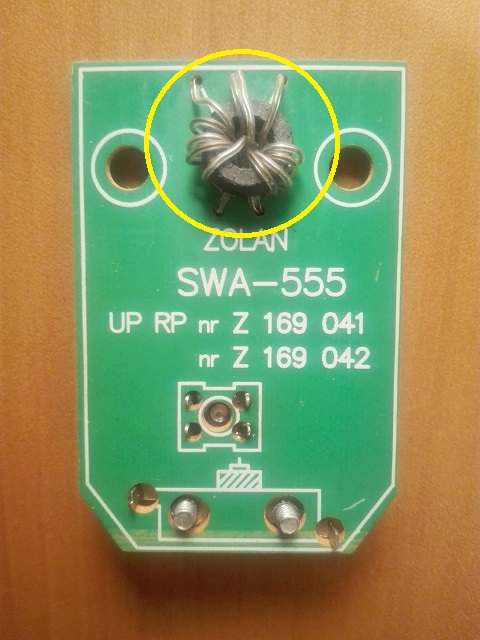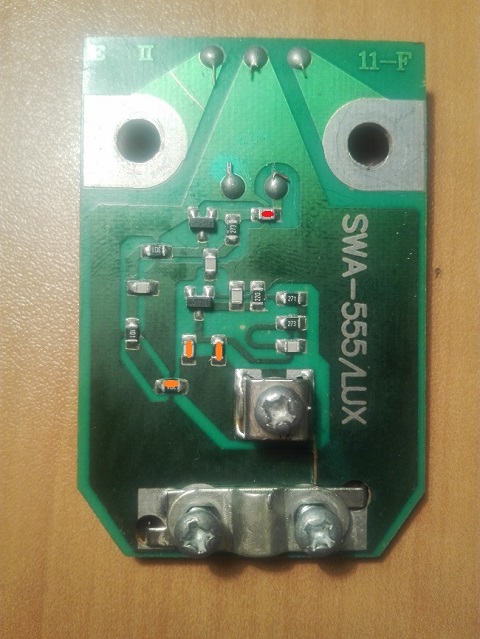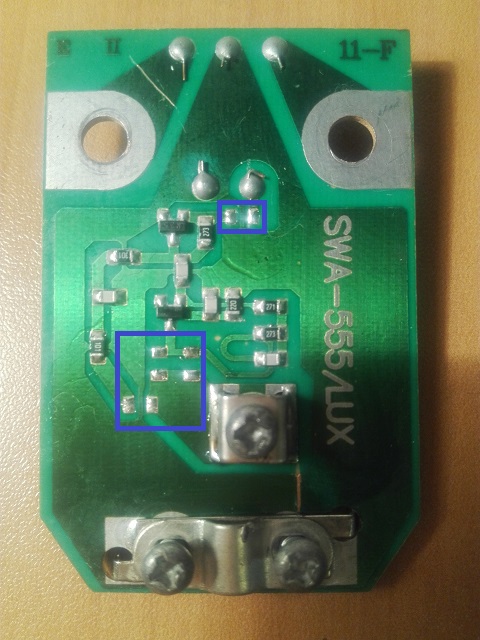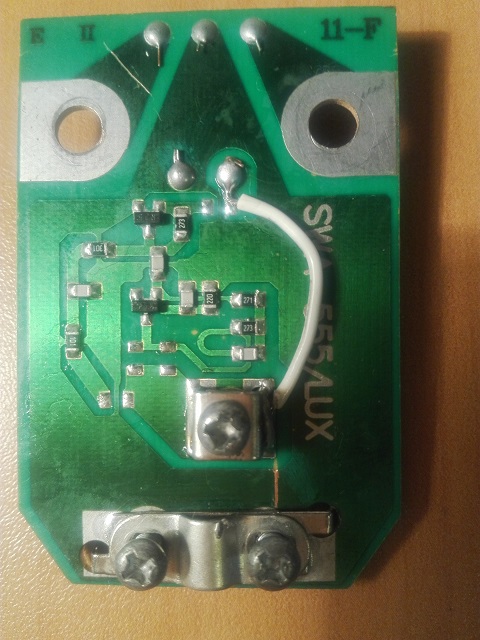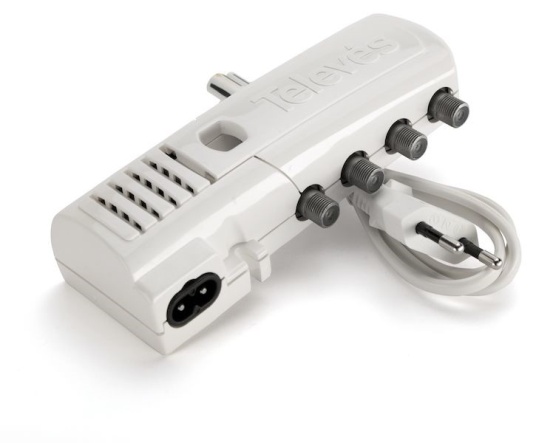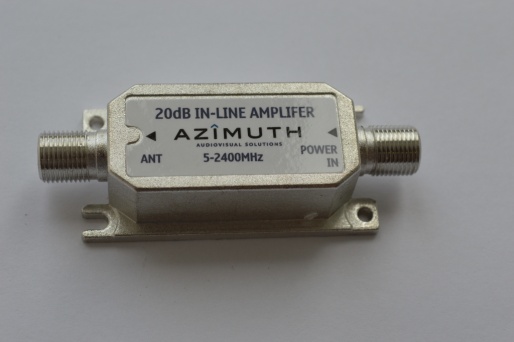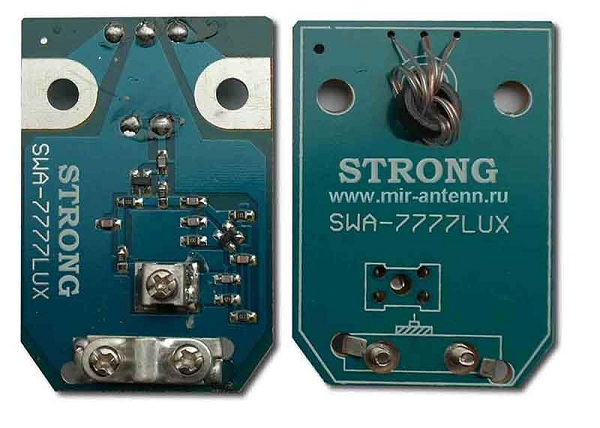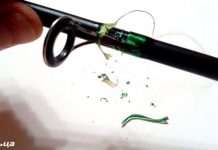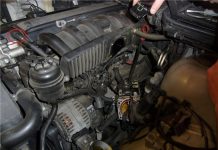In detail: amplifier repair DIY antenna repair from a real master for the site my.housecope.com.
Broken TV antenna power supply? Do not rush to the store for a new one, this master class will allow you to repair your “native” adapter with your own hands and use the saved money for more necessary things.
Visual signs of a malfunction - the LED in the power supply case either does not light up at all, or periodically goes out.
We check the resistance of the primary winding of the mains transformer with a tester by connecting the test leads of the device to the mains plug of the power supply. The measurement result should be in the range of 2.5-2.7 kOhm.
In the absence of a circuit, a break in the wire connecting the plug and the transformer is possible, but a malfunction of the transformer is more common.
Next, we check the resistance at the contacts of the antenna plug, to which the power wire is soldered - the device should show that there is no short circuit.
Unscrew the screws securing the housing cover and remove it.
Now we unscrew the self-tapping screw for securing the board and take it out. In some models of power supplies, the board is simply inserted into special grooves and its fixation with a self-tapping screw is not provided.
Checking diodes D1-D4. The resistance of serviceable diodes in the forward direction will be 450-650 Ohm, in the opposite direction - to infinity, taking into account the process of charging the electrolytic capacitor.
In our case, all the diodes turned out to be serviceable.
Now it's the turn to check the health of the voltage stabilizer microcircuit.
The purpose of the microcircuit pins (see photo): left - power output (12 V), middle - common, right - input (15-20 V).
To make the verification process more visual, I soldered a yellow wire to the output, a black wire to the common one, and a red wire to the last input.
| Video (click to play). |
Naturally, during the repair process, we simply connect the tester probes to these points.
We check the value of the voltage supplying the microcircuit. As you can see in the picture, this parameter is within 21 V, which is normal.
Now we check the output voltage.
Here we see that the output voltage spontaneously rises to 18 V, then.
... drops sharply to almost zero. Such jumps occur two or three times a minute, but still more often the power supply does not produce anything at all.
Note that this type of failure of an integral stabilizer is rare, usually the voltage at its output is completely absent.
This is how the already soldered stabilizer microcircuit looks like.
Its marking - 78L12 - indicates that the stabilizer is designed for a voltage of 12 V. We select instead the same or similar with a stabilization voltage of 9-12 V.
It should be borne in mind that with a supply voltage of 9 V, the amplifier will reduce the gain, and increasing the voltage above 15 V can damage the amplifier.
We insert a new microcircuit and solder it.
We check the voltage at the output of the power supply unit - the tester shows 12.1 V. The repair of the power supply unit is almost complete.
We add that if the antenna has been in operation for more than two years, it is advisable to check the electrolytic capacitor 100 μF, 25 V.
In the event of a loss of capacity by this capacitor, one or two dark horizontal stripes moving in the vertical direction will be visible on the TV screen; the image at the top of such stripes can be bent to the left.
If the capacitor is defective, then it is better to change it with a new one with an operating voltage of at least 50 V.
We collect the refurbished power supply. When it is connected to the network, the control LED lights up - the device is operational.
Being careful, we connect the antenna cable to the connectors of the plug and continue to use the power supply unit repaired by our own hands, while saving on the purchase of a new adapter.
Repair of antenna amplifiers
The repair of antenna amplifiers is usually caused by static electricity (lightning discharges) and a breakdown of the power supply (overvoltage, which rarely happens).
Antenna amplifier is damaged due to a thunderstorm.
Look at the figure with the SWA-2000 amplifier, it shows the transistors involved in amplification and protection (of little help and installed in amplifiers of the 2000 series and above). In case of lightning discharges, the transistor of the amplifier of the first stage and the isolation capacitor most often fail, see Fig.
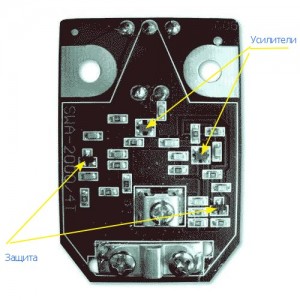
When repairing antenna amplifiers in the first stage, it is advisable to install high-frequency transistors with an F boundary of 1.5 -2 -3 GHz and a low level of intrinsic noise - Ksh, for example, transistors KT391A-2, KT3101A-2, KT3115A-2, KT3115B-2, KT3115V- 2, the noise characteristics of most amplifier models does not deteriorate, and the use of transistors 2T3124A-2, 2T3124B-2, 2T3124V-2, KT3132A-2 reduces Ksh to 1.5 dB, which improves the parameters of the amplifier. This circumstance allows us to recommend replacing the first transistor of the amplifier with those indicated by the latter, even in serviceable, but "noisy" amplifiers in order to improve the quality of their work. In the second stage, you can use cheaper and more powerful transistors KT391A-2, KT3101A-2 and even the series KT371, KT372, KT382, KT399, KT316 and others with a cutoff frequency of about 2 GHz.
If there are difficulties in repairing, in acquiring such transistors, then you can put the widespread KT399, KT316 in the first and second cascades, while there will be no noticeable deterioration of the picture.
It is better to install new transistors on the opposite side of the board, pre-drilling holes for the terminals with a drill with a diameter of 0.5 ... 0.8 mm. It is better to drill so that the hole touches the edge of the platform.
In SWA amplifiers, both transistors operate with a collector current of 10 ... 12 mA. Such a current is acceptable for the second transistor, but constantly exceeds the allowable one for the first, if transistors of the KT3115, KT3124 and KT3132A-2 series are installed. Therefore, after mounting a specific instance, it is necessary to set the operating point of the transistor VT1. To do this, the microresistor R1 is evaporated and instead of it, a trimmer resistor with a resistance of 68 ... 100 kOhm is temporarily connected. Before turning on the power, the resistor slider must be in the position of maximum resistance so as not to damage the transistor. The amplifier is supplied with a voltage of 12 V from the power supply and the voltage drop across the resistor R2 is measured. By dividing the measured voltage by the resistance of the resistor R2, the collector current is found. By adjusting the resistance of the trimmer downward, a collector current of about 5 mA is achieved, which corresponds to a minimum of noise in the characteristics of transistors. Further, instead of a trimming resistor, a constant of the same resistance is soldered.
After that, the printed circuit board and transistors are coated with a layer of radio-technical varnish or a compound to protect it from moisture.
How to avoid such breakdowns, read the article "Why did the antenna amplifier burn out?"
A thunderstorm has passed and the signal from the over-the-air antenna has disappeared. What happened? Why is there no signal in non-analog range not in digital t2? - you ask. The answer is obvious. Thunderstorm! Lightning discharges carry a static voltage that destroys active antenna amplifiers, power supplies, digital set-top boxes t2, and sometimes the televisions themselves. Therefore, during a thunderstorm, it is recommended to turn off all devices from the 220V electrical network, and disconnect the antenna cable from the TV or T2 receiver. Ideally, of course, a lightning protection, a lightning rod with a good ground loop should be installed, but even these precautionary methods do not give a 100% guarantee against lightning striking the antenna.
Lightning protection, of course, is a good thing, but what to do if lightning still got your home.
First you need to understand what went wrong. We start by turning on the TV.If the TV turns on, it's already good, but it happens that the input receiving unit flies out. Suppose you have a t2 receiver installed that receives a digital signal from a decimeter antenna and transmits it to the TV - we also plug it into the 220v network and see if it turns on. The t2 tuner turned on, let's move on (turning on the TV and t2 set-top boxes does not guarantee that one of them has not failed the receiving unit). Next, we check the performance of the antenna power supply by the same analogy as the previous two devices. The power supply has turned on, it's already good (if it did not turn on, replace the power supply). And at the end we check the amplifier board. Further, the speech will go for those who are friends with a soldering iron, if you are not like that, then just buy and replace the antenna amplifier with the same type as you had (swa 777, 999, 9999, 3501, 2000, 7777, etc. or for any similar in its characteristics)
Consider the repair of terrestrial antennas from the repair of antenna amplifiers from the so-called "Polish antennas", using the example of an amplifier Eurosky SWA-2000 fig. 1
All amplifiers are a two-stage aperiodic amplifier based on microwave bipolar transistors, connected in a circuit with an OE. For those who are friends with a soldering iron, I think it is not necessary to tell that the amplifier has two stages with decoupling along the power circuit, etc. Let's go straight to practice - during lightning discharges, the transistor of the amplifier of the first stage and the isolation capacitor, which are shown in the figure below, most often fail.

Successful repairs. And let Zeus take his lightning away from you! )
If your antenna with an amplifier does not receive a stable DVB-T2 digital television signal, then often the problem is not that the amplifier is weak, but that it is not needed there at all. Yes, yes, after the arrival of digital terrestrial television, the situation with signal reception in some respects has changed a lot and in many cases, the amplifier in the antenna becomes simply unnecessary, moreover, it becomes the cause of an unstable, and sometimes even absent signal.
I already wrote about the reason for this phenomenon and the methods of dealing with it here, so I will not repeat myself and I will not explain why the alteration is needed, which I want to talk about in this article. Namely, as an amplifier for the antenna "Polish" to convert into a matching board.
What is needed for this? Actually the amplifier itself, it can even be faulty, a piece of wire of 3 centimeters and a soldering iron. Task - Make a matching board from the amplifier board, which cannot always be bought in stores.
On amplifiers from antennas of the "lattice" type there is a balancing transformer, and we will need it to match the antenna with the signal consumer. In the photo below, the transformer is circled in yellow. (In amplifiers for other types of antennas, you can also make a similar alteration)
There is no need to solder it, everything is much simpler. On the amplifier board, from the side of the radio elements, you need to remove the excess. Namely, unsolder the capacitor at the output of the transformer (marked with a red dot) And unsolder the piping elements in the terminal circuit to which the central core of the cable is connected (marked in orange)
Attention! In amplifiers with different numbers, the number of elements and their location may differ, but the meaning remains the same, disconnect the transformer and the terminal from the amplifier circuit.
I did it like this! (Photo below) Of course, I washed all the soldering points with alcohol ... .. well, how did I wash it? - Rubbed with a thin layer, you know))) Although it is not necessary to do this.
The final stage - With a short wire, you need to connect the free output of the transformer with the terminal for the central core of the cable. That's it, the approval board is ready! You can put and try. And yes! Do not forget to put a regular TV plug instead of the power supply. The one with a separator from the power supply unit will not work.
That's all! Found it useful? Share with your friends, the social media buttons are below, this will help the development of the site. Thanks!
Since I nevertheless found the reason and sorted it out, I decided to refine this entry. It all started with the fact that I replaced the original car radio with the S150, which I presented earlier. But I ran into the problem of poor radio reception. In principle, I don't even listen to him, but I love that everything works as it should.
On the internet, at one of the specialized forums on this radio tape recorder, I met a lot of negativity on radio reception, and many argued that the reason was precisely in it. But personally, I began to doubt it. Well, I decided to come to the truth after all.
Having met on the Internet a description of the fact that there is an amplifier in the VW Polo antennas and knowing that they need power, I doubted that everything was correctly powered by me. According to the scheme of additional power supply, the amplifier is not, which means that only the car radio itself could power it via the antenna cable. In the originals, this is understandable, but in Chinese radio tape recorders this is unlikely.
But with the Chinese radio tape recorder, so to speak, there was an adapter with power going into it. Previously, not knowing that there is an amplifier in the antenna, I did not pay attention to this fact. but now I'm thinking. The adapter is powered for an antenna or an amplifier. The box is large and too big for a simple galvanic isolation.
And yes, my suspicions were correct. Judging by the elements inside, this is an amplifier. And this means that the power for the amplifier in the antenna does not go. Well, such a scheme is not workable.
Sorting out further, I found from the Chinese clean adapters with galvanic isolation, so to speak, for powering the antenna.
But I said it loudly. These are the Chinese. They save on everything, therefore there is only one capacitor separating the radio tape recorder from the antenna. And such a scheme, to put it mildly, is not effective as it will generate radiation.
Yes, and I did not have this adapter available. And the radio tape recorder is removed. Therefore, I decided to do the denouement myself. To make it, it is enough to have a 1 kilo ohm resistor and a 10000pF ceramic capacitor.
But I went a little trickier. I disassembled the amplifier circuit. Of course, there was no other way to throw the amplifier out of the antenna and that's it, but I didn't want to remove the ceiling just to remove the antenna.
I disassembled, pulled out the board and inserted another one there. In the bins I found a palt with a decoupling for powering a Polish antenna, so to speak. It has been lying around for a long time. The board was in poor condition.
I disassembled it, irradiated it and reassembled it.
I drew a small diagram. If anyone does not understand, I can explain.
Well, I shoved it back into the case.
The result is an adapter with a power supply to the amplifier in the antenna through the wire.
Reception has improved significantly. Mine is happy.
Here I will add another simple scheme, it may be even easier here.
Is your TV, radio, mobile phone or kettle broken? And you want to create a new topic about this in this forum?
First of all, think about this: imagine that your father / son / brother has an appendicitis pain and you know from the symptoms that it is just appendicitis, but there is no experience of cutting it out, as well as the tool. And you turn on your computer, access the Internet on a medical site with the question: "Help to cut out appendicitis." Do you understand the absurdity of the whole situation? Even if they answer you, it is worth considering factors such as the patient's diabetes, allergies to anesthesia and other medical nuances. I think no one does this in real life and will risk trusting the life of their loved ones with advice from the Internet.
The same is in the repair of radio equipment, although of course these are all the material benefits of modern civilization and in case of unsuccessful repairs, you can always buy a new LCD TV, cell phone, iPAD or computer. And for the repair of such equipment, at least it is necessary to have the appropriate measuring (oscilloscope, multimeter, generator, etc.) and soldering equipment (hairdryer, SMD-hot tweezers, etc.), a schematic diagram, not to mention the necessary knowledge and repair experience.
Let's consider a situation if you are a beginner / advanced radio amateur soldering all sorts of electronic gizmos and having some of the necessary tools. You create an appropriate topic on the repair forum with a short description of “patient symptoms”, ie. for example “Samsung LE40R81B TV does not turn on”.So what? Yes, there can be a lot of reasons for not switching on - from malfunctions in the power system, problems with the processor or flashing firmware in the EEPROM memory.
More advanced users can find the blackened element on the board and attach a photo to the post. However, keep in mind that you replace this radio element with the same one - it is not a fact that your equipment will work. As a rule, something caused the combustion of this element and it could “pull” a couple of other elements along with it, not to mention the fact that it is quite difficult for a non-professional to find a burned-out m / s. Plus, in modern equipment, SMD radio elements are almost universally used, soldering which with an ESPN-40 soldering iron or a Chinese 60-Watt soldering iron you risk overheating the board, peeling tracks, etc. The subsequent restoration of which will be very, very problematic.
The purpose of this post is not any PR of repair shops, but I want to convey to you that sometimes self-repair can be more expensive than taking it to a professional workshop. Although, of course, this is your money and what is better or more risky is up to you.
If you nevertheless decide that you are able to independently repair the radio equipment, then when creating a post, be sure to indicate the full name of the device, modification, year of manufacture, country of origin and other detailed information. If there is a diagram, then attach it to the post or give a link to the source. Write down how long the symptoms have been manifesting, whether there were surges in the supply voltage network, whether there was a repair before that, what was done, what was checked, voltage measurements, oscillograms, etc. From a photo of a motherboard, as a rule, there is little sense, from a photo of a motherboard taken on a mobile phone there is no sense at all. Telepaths live in other forums.
Before creating a post, be sure to use the search on the forum and on the Internet. Read the relevant topics in the subsections, perhaps your problem is typical and has already been discussed. Be sure to read the article Repair strategy
The format of your post should be as follows:
Topics with the title “Help fix the Sony TV” with the content “broken” and a couple of blurred photos of the unscrewed back cover, taken with the 7th iPhone, at night, with a resolution of 8000x6000 pixels are immediately deleted. The more information about the breakdown you put in a post, the more chances you will get a competent answer. Understand that the forum is a system of gratuitous mutual assistance in solving problems and if you are dismissive of writing your post and do not follow the above tips, then the answers to it will be appropriate, if anyone wants to answer at all. Also note that no one should answer instantly or within a day, say, no need to write after 2 hours “That no one can help”, etc. In this case, the topic will be deleted immediately.
You should make every effort to find a breakdown on your own before you get stuck and decide to go to the forum. If you outline the whole process of finding a breakdown in your topic, then the chance of getting help from a highly qualified specialist will be very great.
If you decide to take your broken equipment to the nearest workshop, but do not know where, then perhaps our online cartographic service will help you: workshops on the map (on the left, press all buttons except “Workshops”). You can leave and view user reviews for workshops.
For repairmen and workshops: you can add your services to the map. Find your object on the map from the satellite and click on it with the left mouse button. In the field “Object type:” do not forget to change to “Equipment repair”. Adding is absolutely free! All objects are checked and moderated. A discussion of the service is here.
Since I nevertheless found the reason and sorted it out, I decided to refine this entry. It all started with the fact that I replaced the original car radio with the S150, which I presented earlier.But I ran into the problem of poor radio reception. In principle, I don't even listen to him, but I love that everything works as it should.
On the internet, at one of the specialized forums on this radio tape recorder, I met a lot of negativity on radio reception, and many argued that the reason was precisely in it. But personally, I began to doubt it. Well, I decided to come to the truth after all.
Having met on the Internet a description of the fact that there is an amplifier in the VW Polo antennas and knowing that they need power, I doubted that everything was correctly powered by me. According to the scheme of additional power supply, the amplifier is not, which means that only the car radio itself could power it via the antenna cable. In the originals, this is understandable, but in Chinese radio tape recorders this is unlikely.
But with the Chinese radio tape recorder, so to speak, there was an adapter with power going into it. Previously, not knowing that there is an amplifier in the antenna, I did not pay attention to this fact. but now I'm thinking. The adapter is powered for an antenna or an amplifier. The box is large and too big for a simple galvanic isolation.
And yes, my suspicions were correct. Judging by the elements inside, this is an amplifier. And this means that the power for the amplifier in the antenna does not go. Well, such a scheme is not workable.
Sorting out further, I found from the Chinese clean adapters with galvanic isolation, so to speak, for powering the antenna.
But I said it loudly. These are the Chinese. They save on everything, therefore there is only one capacitor separating the radio tape recorder from the antenna. And such a scheme, to put it mildly, is not effective as it will generate radiation.
Yes, and I did not have this adapter available. And the radio tape recorder is removed. Therefore, I decided to do the denouement myself. To make it, it is enough to have a 1 kilo ohm resistor and a 10000pF ceramic capacitor.
But I went a little trickier. I disassembled the amplifier circuit. Of course, there was no other way to throw the amplifier out of the antenna and that's it, but I didn't want to remove the ceiling just to remove the antenna.
I disassembled, pulled out the board and inserted another one there. In the bins I found a palt with a decoupling for powering a Polish antenna, so to speak. It has been lying around for a long time. The board was in poor condition.
I disassembled it, irradiated it and reassembled it.
I drew a small diagram. If anyone does not understand, I can explain.
Well, I shoved it back into the case.
The result is an adapter with a power supply to the amplifier in the antenna through the wire.
Reception has improved significantly. Mine is happy.
Here I will add another simple scheme, it may be even easier here.
Antenna amplifier for TV is widespread in the CIS. It is the optimal solution for improving the quality of the tele-signal. The intrinsic gain in the antenna does not play a significant role, but its antenna amplifier seriously affects the picture quality.
The best amplifiers that have proven themselves over the years are SWA-7, 14, 17, 107, 109, 2000. The SWA-2000 is a newer antenna amplifier with two additional transistors. The amplifier includes two transistors VT1 and VT2, which are included in accordance with the circuit to the OE. The signal is removed at the collector in the transistor VT2 and is fed through the capacitor C9 to the cable. The location of additional transistors VT3 and VT4 is carried out in active circuits, which provide a base bias voltage in transistors VT1 and VT2.
Despite the fact that digital television is being actively introduced, there will always be demand for antennas with active amplification, since the signal to the TV tuner is supplied using antennas with a decimeter range.
So, to improve the television signal, they use an antenna amplifier. The best gain is achieved when the antenna amplifier is installed not near the TV input, but in close proximity to the antenna. To reduce attenuation, it is better to use modern coaxial cables. The amplifier is powered by a coaxial cable.The voltage rating of the power supply in the antenna amplifier is most often 12 V, and the attenuation value of the cable is 0.1 - 0.5 decibels per m, if we take different television channels.
In rural areas, when telecentres are at a great distance, amplifiers are used, the gain of which is more than 100 dB. If the amplifier was selected incorrectly, or the feeder and antenna are not matched properly, then due to the excitation of the amplifier, the TV screen will show with noise and snow.
Although you can buy an antenna amplifier for your TV at almost any corner, most of them use a standard circuit. That is, they are two-stage aperiodic amplifiers having bipolar high-frequency transistors connected in accordance with the OE circuit. Let's take a closer look at these models: SWA-36 and SWA-49
The SWA-36 amplifier contains broadband amplification stages with transistors VT1 and VT2. The value of the antenna signal, through the matching transformer and the capacitor C1, is fed to the base in the transistor VT1, which is included in the circuit with the OE. The determination of the operating point in the transistor is carried out due to the bias voltage, which is determined using the resistor R1. In this case, due to the action of negative feedback (OOS), the characteristic in the first stage becomes linear, the position of the operating point is stabilized, however, the gain value decreases.
No frequency offset is applied to the first stage. The execution of the second stage is also carried out using a transistor in a circuit with an OE and with OOS, due to the passage of voltage through the resistors R2 and R3. However, there is still a current OOS, through the resistor R4, which the emitter circuit possesses. It stabilizes the transistor VT2. To avoid large gain losses, the resistor R4 is grooved using a capacitor C3, which has a relatively low capacitance (10 pF).
The result of this is that the lower frequencies in the range of capacitance on the capacitor C3 will be significant and the AC feedback leads to a decrease in the gain, due to which the same frequency response of the amplifier is corrected. The SWA-36 amplifier has drawbacks, among them the passive loss that the output circuit has.
The device of the SWA-49 amplifier can be considered the same, with the exception of some differences.
It implements the best decoupling of the power circuits, due to the filters L1C6, R5C4 and increased the gain, thanks to the capacitors C5 and C7.
In a high-quality antenna amplifier, the signal-to-noise ratio should increase. However, any electronic amplifier necessarily has its own noise, which is amplified like the signal. For this reason, the traces of important parameters in the antenna amplifier need to highlight the noise figure. If its value is large, it is pointless to increase the gain.
Systems of cable and broadcast television broadcasting are developing everywhere every year. However, despite the rapid growth of the network and the expanded capabilities of television equipment, the picture quality on the TV screen is poor. This is due to the fact that the reception of the antenna's TV signal depends on various factors: correct installation, design and shape of the device, distance to the repeater. Improving the quality of the resulting image will help stand-alone amplifier or replacing the receiver with a more powerful device. In this review, we will look at how to amplify the weak, unstable signal of a TV antenna.
Before studying radio technical innovations, it is necessary to analyze why the level of functioning of the receiver is low. Interference and poor picture quality can be caused by:
- significant removal of the dwelling from the repeater;
- wrong choice of television antenna;
- high level of natural noise;
- external obstacles to signal reception: high-rise buildings, trees, industrial buildings;
- failure of the cable;
- incorrect orientation of the transmitter;
- the presence of metal objects near the antenna that can conduct electricity;
- distribution of the TV signal to several receivers;
- outdated technology.
- Reposition the antenna. As a rule, it is directed to the side transmission tower.
- Purchase of an antenna amplifier. They are electrical devices that connect directly to the antenna and give an impetus to improve the received signal.
- Expand the number of antennas for a clearer picture, installed at the highest place.
- Change the device to a more powerful TV antenna.
- Remove all objects and metal objectsthat may interfere with the reception of the TV signal.
- Check the TV cable for integrity. In case of shorts or breaks, replace it with a new one. For a good signal, it is important to choose the right cable.
- Create effect common-mode antenna array (SAR). It consists in the fact that identical receivers constitute a complex system that operates on a common matched load so that the phases of the signal are the same.
Knowing how to improve the TV signal, you can minimize the interference of the image on the screen and enjoy high-quality viewing regardless of the distance from the TV center.
Like all radio technical devices, devices have their own pros and cons. The advantages of antenna amplifiers include:
- even a weak TV signal is received due to the operation of the device;
- minimum noise figure;
- improvement of the signal in a wide frequency band of several wavelength ranges.
The main disadvantages that users may face:
- overload of the device from powerful signals in the VHF range (49-230 MHz);
- self-excitation of the amplifier;
- the device is susceptible to currents of lightning electric discharges;
- passive losses occur at the output.
You can design a simple device that amplifies your TV signal for your TV with your own hands. Such a device has low power consumption, does not create significant interference, and has a frequency range of up to 900 MHz. The low-voltage amplifier with a power supply of 2.7-5.5 V draws a current of 3 mA, it works very quietly.
The principle of operation is as follows. The input "1", which is shown on the microcircuit, is supplied with voltage. Thanks to the resistor R1, an offset is created into the working area. It is connected to input "2". The input signal comes to the output "6", while the amplified signal is removed from the node "3" and sent to the receiver. If the microcircuit is correctly assembled, there is no need to configure it. By the way, an antenna for a TV can also be made by hand.
For the correct antenna amplifier selection, pay attention to the following parameters.
- Distance from repeater. This indicator should be within 10-150 km.
- Frequency range.
- Signal level at the output of the device. The best option is 100 dB per microvolt.
- The gain of the device. This figure should be at least 40 dB.
- The type of device for which you want to amplify the TV signal.
- Noise figure. It is recommended not to exceed this parameter by more than 3 dB.
- Consumption current. The optimal value is considered to be 30-60 mA.
- Location: on the receiver or near the device.
Note! For digital television, a device with a supply voltage of 5 V is preferable. If you choose a DVD-T2 digital set-top box with this parameter, you will not need to buy a power supply for the antenna amplifier.
Various amplifiers are being sold on the radio market to improve image quality. The gain can be adjusted in the devices. Most devices have multiple outputs for connecting to multiple TVs.
- Televes 5523. The Italian company has presented an improved device with 5 outputs. Due to the high gain of 16 dB, the radio device reduces the level of persistent noise and television interference.The device operates from a separate power source, which is included in the package of the device.
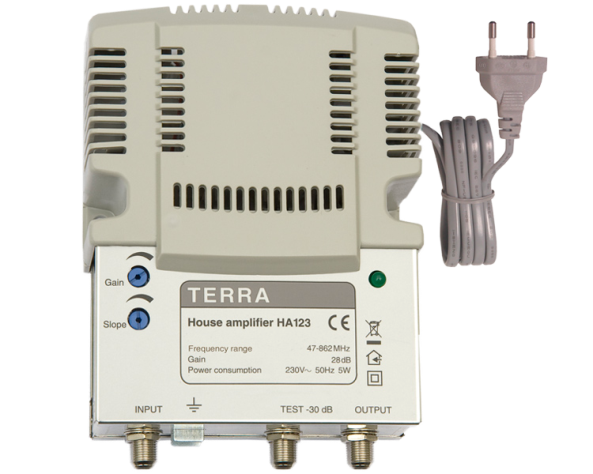
- Gecen A05-02. The device increases the signal level to 19-21 dB. Operating frequency ranges for satellite TV are within 950-2400 MHz, terrestrial - 5-950 MHz. Power to the Gecen A05-02 broadband amplifier is supplied through a coaxial cable from a satellite receiver (read more about installing satellite TV). In order to receive an amplified signal of terrestrial TV, an additional power supply is purchased.
Polish amplifiers seriesSWA... They are installed mainly on "arrays" of antennas and have different gain factors. The frequency range varies from 49 to 790 megahertz. The supply voltage is 9 volts. Installation is carried out using a stud or threaded connection.
Various factors can negatively affect the TV signal level. Modern radio technology devices help to increase it. They have a number of advantages: portability, high gain, and a large selection of models. Thanks to the joint work of the antenna and the amplifier, you can watch television in good quality.
Good day!
I have a 2-storey house in Butovo (5 km from Moscow along the Simferopol highway).
I don't really watch TV, so I don't need a plate, and there are several TVs. I bought an antenna “LOCUS” of the “Meridian” series L 025.62 () ”>, fixed it above the roof - 20 channels, almost everything is perfectly visible. About a year has passed, I turn it on - you can see only 5 channels, and on each in the middle of the picture there is a healthy strip. I stick in indoor horns - these are the same 5 channels, but you can see better. We have constant voltage drops, I think the amplifier at this antenna burned out. Tell:
1) Am I guessing correctly and, if so, is it realistic to fix / buy a new one?
2) This antenna with a built-in amplifier, after which a crab is stuck in me and divorced to 4 TVs. The picture is worse than if you directly stick the antenna into the TV. Is it possible to throw out the built-in amplifier and buy an external one, or do you need to change the antenna to a model without a built-in amplifier? Will the picture be better from replacing the built-in amplifier with an external one?
3) If someone would be interested to help not only in word, but also in deed - write, pliz, in a personal with prices.
Thanks in advance for your answers!
- Right. Buy.
- You can throw out the amplifier and replace it with a passive balun. And install an external amplifier.
- .
But in connection with the collapse of the Union, the factories that manufacture antennas for television receivers simply stopped producing them. To replace our television products, they began to import imported ones. As our people say, a holy place is never empty. In our markets, it became possible to buy a good imported TV, and in addition, sellers offered an imported multichannel TV antenna at a reasonable price.
The antenna kit included an antenna amplifier and a power supply for it. The antenna cable had to be purchased separately. I did not leave much effort to install the antenna I just bought on the market myself. To do this, it was necessary to have only a tool: a screwdriver, a pocket knife and a wrench.
After installing the television antenna on a specially prepared site, and turning on the TV, we tune it to the transmitting television center.Having adjusted the TV for image quality, the antenna, we fix and fix it so that it does not unfold during strong gusts of wind.
Recently, satellite television has become widespread for receiving television channels. The quality of the received television signal from the satellite, in many respects, exceeds the signal reception from an ordinary all-wave television antenna. Of course, not everyone can afford to buy a satellite dish as we say, and therefore a simple but affordable all-wave antenna with an amplifier is in great demand.
But here's one trouble, during her operation, sometimes malfunctions occur, for one simple reason. During a thunderstorm, we forgot to turn off the power supply from the 220 Volt outlet, and at the same time the TV cable with a plug, from the antenna socket of the TV. As a result, the failure of the tuner, that is, the TV receiver, or a lot of expensive radio components burn out.
My advice, do not forget to turn off the TV receiver and antenna from the 220 volt electrical network during a thunderstorm. So you will save not only the TV, but also the antenna amplifier, and in addition your hard-earned money, which could have been spent on repairing the TV.
Next we will have a story about the repair of the power supply unit of the TV amplifier. It consists of a power step-down transformer, a getinax board, four low-power silicon diodes, one electrolytic capacitor, a voltage regulator, and a signal LED.
Most often, an electrolytic capacitor fails in the power supply of the antenna amplifier. This malfunction is displayed on the TV screen in the form of broken lines, and most often you can observe how a black wide strip moves across the image. Immediately, without thinking twice, it is necessary to disassemble the power supply and replace the failed electrolytic capacitor with a capacity of 100 μF, 25 V. In rare cases, the voltage regulator itself fails, which outputs a stabilized constant voltage of 12 Volts at the output to power the antenna amplifier. The nature of the stabilizer malfunction is also displayed on the TV screen in the form of goosebumps or snow.
| Video (click to play). |
Anyone who knows how to work at least a little with a soldering iron will have no difficulty in replacing broken parts.
Good luck everyone

